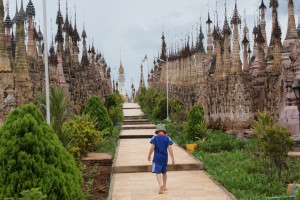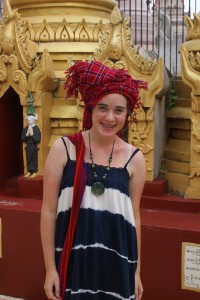We visited Kakku on our last day in the Inle region.
I wasn’t sure how different it would be from all the other Buddhist sites we’d seen – after all, Kakku has been described as yet another assemblage of pagodas- and we had seen plenty. How wrong we were. It was one of the most memorable sites we saw in all our Myanmar travels.
Unlike almost everywhere else to see in the Inle region, one reaches Kakku by land.
You must travel via the Shan capital of Taunggyi. The local Shan people are very proud of Taunggyi – it’s a real city, with a university and it is growing fast. The primary reason for stopping there is to register for the trip and meet the designated Pa-O guide. Since Kakku is in Pa-O territory, a local guide is mandatory. Our guide was enchanting – a young woman student at the university who went out of her way to make sure we had a agreat time.
First we explored the market at Taunggyi. It was pouring with rain and so we headed into what seemed like a labyrinth of stalls to explore, find something to eat, and, unusually, to look for a particular brand of shampoo. Gal had decided that the local shampoo she had found in our hotels was better than anything she uses back home, so we went searching for some to take back with us. The Taungyyi market isn’t memorable – there certainly was nothing of special interest, but then again, it only caters for locals – Taunggyi doesn’t see foreigners dropping by very often. Our foray was a complete success as we found the shampoo and bought enough to last for a few months. I don’t expect we’ll see Myanmar shampoo on our local shelves anytime soon.
We stopped at a tea shop for the typical Shan snack of fried donuts, samosas and sweet tea, and I was amazed to see a huge variety of newspapers allocated to one topic – sports. It turns out that Myanmar has about 50 daily or weekly dedicated sports newspapers – it is hard to escape the absolute obsession that people in Myanmar have with soccer – it appears that watching and reading about European championship and English Premier league games are a major priority for much of the population.
Also, it seemed pretty clear to me that no one really bothers to read the “real” newspapers – there is no free press in Myanmar and the regular newspapers are government propaganda mouthpieces. The English language “New Light of Myanmar” newspaper is full of news that generally revolves around the various daily rounds of government ministers, some sport, some international “news” (such as “Crocodile escapes in Florida”) and very oddly, almost all the international news gives as it source “Internet”. The last page is almost fully devoted to slogans regarding the hard work the army is doing by building up the country.
We drove on to Kakku – it’s at least an hour from Taunggyi, but the road is good. Our guide pointed out that the local houses are built without windows and we saw large houses (made of palm), with no windows at all. She told us that the Shan plateau has a real winter and houses with no windows stay warm longer.
We arrived at Kakku – the sun was blazing now, it was a glorious day and we were the only foreigners around.
Kakku apparently dates back thousands of years to the time of the great Emperor Ashoka, who unified India around 300 BC and whose empire included modern-day Myanmar. Ashoka spread Buddhism throughout his lands and is believed to have brought a relic of the Buddha to Kakku and enshrined it there in a pagoda. True or not, the result has been that over the centuries Shan dignitaries and nobility have built their own stupas next to the huge Ashoka pagoda, resulting in a forest of pagodas. The effect is amazing.
Kakku has been heavily restored as opposed to Sankar or Indein, so the Indiana Jones effect isn’t evident, but the sight is amazing in its own way. It is simply stunning and photo’s only do it partial justice. We explored the site with our guide for about an hour – she was great, explaining to us how the shape of the Stupa came to be (fold a Bodhi tree leaf in half and you’ll see), various Pa-O customs and traditions, and doing whatever she could to make the site meaningful and special to all of us. Her english was excellent. She also taught us how to dress like the Pa-O which was a lot of fun!
The kids loved Kakku. It is a great place to explore, with its almost maze-like quality. The whitewashed stupas stretch out in every direction.
We had lunch at one of the many tea stalls nearby – Shan food is delicious and we had been eating it all over Myanmar – but here we had a special local soup as well, which was excellent. The local condiment is a kind of green cabbage-like vegetable, pickled and very spicy – simply impossible for us to eat, but this is almost only what our guide ate. In general, we enjoyed Shan food far more than the typical Myanmar curries – well, the kids did at least, and they dictated what we ate!
On the way back to Taunggyi we had planned to visit a local village, but the heavens opened up and we decide not to leave the car in the torrential rain. We had been very lucky with the weather at Kakku. In fact, this was the only really rainy day that we experienced on our whole trip, and we were there in the monsoon season.
We stopped at one of Myanmar’s two wineries on the way back to Nyaung Shwe. The winery is about ten years old and run by Germans. We tasted the local wine, which was ok, and I spent a good while chatting to the winemaker – a young German guy who has been living in Myanmar for about five years and clearly doesn’t have too much opportunity to get to speak to foreigners. He explained that life in Myanmar for an expat is excellent, though the cost of living has climbed dramatically in recent years. The currency has been kept artificially strong and this has made life tougher for all. Certainly from our point of view, Myanmar was proving more expensive than other countries we had toured in Asia. The wine wasn’t cheap either, but he said the growing middle class has money to indulge in expensive wine. Traditionally, alcohol consumption in Myanmar has centered around spirits and beer, in fact, we saw ads for local whisky everywhere and it was available over the counter every where as well – even in the smallest grocery stores. But wine has a certain prestige to it, and the wealthier class is beginning to drink a lot of it.
Arriving back in Nyaung Shwe, we moved to a new hotel – the Amazing Hotel (yes, that is the name). No pool and only an average breakfast, but the rooms were outstanding.
(PS: I am now custom -designing trips to Myanmar. For more details click here).



